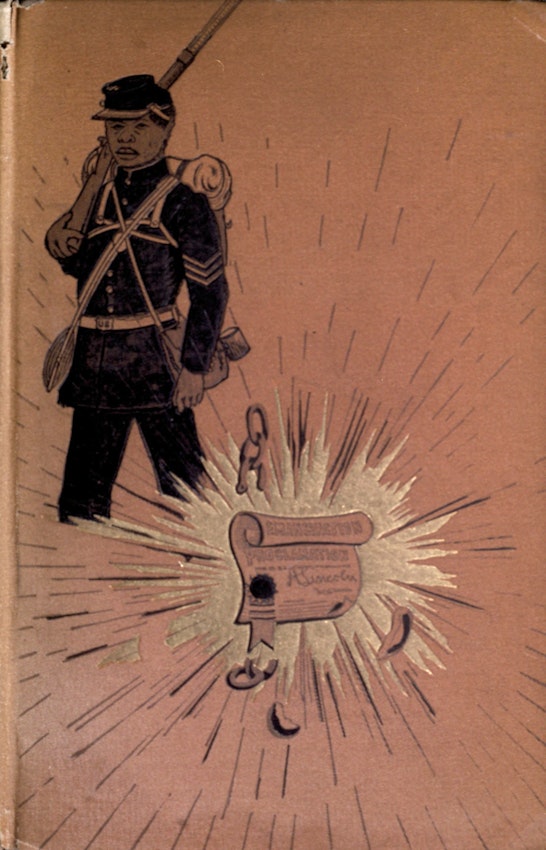
George Washington Williams’ History of the Negro Race in America (1882–83)
George Washington Williams (1849–1891) lived the sort of picaresque life not often imagined possible for nineteenth-century African Americans. At the age of fourteen he falsified an identity and joined the Union army for the last battles of the Civil War. He continued his military career, serving in Mexico under General Espinosa and in the Indian Wars, until he was honorably discharged due to an injury. His life then moved to a series of firsts, accomplishments, blunders, setbacks, social networks, and burnt bridges. He briefly enrolled at Howard University, then left to eventually become the first Black graduate of the Newton Theological Seminary in Massachusetts, an ordained Baptist pastor, the founder of a Black newspaper in Washington D.C., a lawyer and then elected legislator in Ohio — all before beginning to work on his first major publication, History of the Negro Race in America from 1619 to 1880.
One thing Williams was not, however, was a trained historian. A pure autodidact in the field, he forged a historiographical process through dedicated study of primary sources, exhausting the resources of the Ohio State Library, and traveling east to the Library of Congress and New York Historical Society. Perhaps Williams was dedicated to comprehensive documentation because he lacked formal credentials. He not only reviewed official government records, but also pamphlets and newspapers, going so far as to conduct interviews with members of Black military regiments in the Southwest when his requests for information through official channels were denied. His evidentiary enthusiasm is clear from the preface of the first volume where he recounts the genesis of his work:
I was surprised and delighted to find that the historical memorials of the Negro were so abundant, and so creditable to him . . . I became convinced that a history of the colored people in America was required, because of the amply historically trustworthy material at hand.
That passionate study led to the 1882–83 publication of the two-volume History. Divided into three major parts, “Preliminary Considerations”, “Slavery in the Colonies”, and “The Negro During the Revolution”, the first volume actually begins far before 1619, with the Book of Genesis (a historical bound that speaks to Williams’ encyclopedic vision). The initial chapter of the book is thus more biblical history than scientific, calling on theological studies to counter popular dehumanizing theories about Black people based on scriptural arguments. Next comes “The Negro in the Light of Philology, Ethnology, and Egyptology”, which moves forward some centuries, tracing ethnographic and linguistic understandings of whom is referred to with the term “Negro”. Williams continues onward with geographic and historical overviews of various West African tribes and societies. Unfortunately, this first part is Williams’ most creatively non-factual, full of imaginative language that reads more like an adventure tale than historical study, as seen in this excerpt about battles between the English colonial army and the Ashanti:
All the native and British forces were compelled to retire to the forth; while the Ashantee troops, inspired by the dashing bearing of their new king, closed in around them like tongues of steel. . . . The screams of fainting women and terrified children, the groans of the dying, and the bitter imprecations of desperate combatant,- a mingling medley - swelled the great diapason of noisy battle.
History of the Negro Race in America evens out once we reach the 1619 arrival of enslaved Africans in the Virginia colony, and the first volume’s latter parts are bolstered by the author’s ability to more directly access primary sources and references. He delves into legal and legislative rulings around slavery and freedom in each of the twelve colonies, comparing and contrasting the situations for enslaved people before the American Revolutionary War. His second volume, published a few months after the first, kicks off with “Negroes in the Army and Navy” at the start of the nineteenth century and continues through the Civil War into Reconstruction, concluding with a “Retrospection and Prospection” on the “Negro Power of Endurance”.
 Scroll through the whole page to download all images before printing.
Scroll through the whole page to download all images before printing.Cover of George Washington Williams, A History of the Negro Troops in the War of the Rebellion, 1861- 1865 (New York: Harper and Brothers, 1888) — Source.
Perhaps due to his own extensive military history, Williams thrives when writing about the Revolutionary War, devoting one of his longest chapters to “Military Employment of Negroes 1775-1780”, which details all aspects of the conflict — from the shooting of Black and Indigenous sailor Crispus Attucks at the Boston Massacre, widely regarded as the first American to die in the war, through the cessation of hostilities. The chapter contains transcriptions of military rulings and correspondence, charts, tables, and some glimpses of Williams’ innovative use of newspapers as primary sources. The mixture of directly quoted and fully reprinted documents and Williams’ opinionated authorial voice make his history a unique contribution, a view into African American history as well as into one African American’s idiosyncrasies.
After years of research and relationship building, Williams’ debut was subject to reviews and critique across the major periodicals of the day. Some reviewers gave shallow praise, simply impressed that a Black man could accomplish a task of this magnitude, while others had severe critiques of Williams’ style and methodology, especially regarding the early speculative chapters. Perhaps the larger issue that brought out reviewers’ red pens was his tone. With a background in both clergy and the law, Williams indulged in the sort of affected prose that was common in the 1880s but that reviewers seemed to find issue with when coming from a new Black historian. There were also complaints that he did not have enough professional respect for colleagues. Throughout History of the Negro Race, Williams harshly critiqued historians that he thought were citationally lax or faltering in their professional objectivity. He felt comfortable correcting the historical record definitively, as in this footnote relating to Benjamin Banneker, an eighteenth-century polymath and, most famously, publisher of almanacs:
William Wells Brown, William C. Nell, and all the Colored men whose efforts I have seen, have made a number of very serious mistakes respecting Banneker’s parentage, age, accomplishments, etc. He was of mixed blood. His mother’s name was not Molly Morton, but one of his sisters bore that name.
I have used the Memoirs of Banneker, prepared by J. H. B. Latrobe and J. Saurin Borris, and other valuable material from the Maryland Historical Society.
The chiding tone of this footnote is among his more gentle reproofs, and certainly was not something as obvious as Williams claims. In the Houghton Library copy of the History, there is a handwritten annotation from Alonzo Rothschild, jeweler and previous owner, showing that Latrobe himself disagreed with Williams.
In spite of the somewhat-excusable errors in methodology and irreverence for his peers, even Williams’ most critical reviewers noted that they were being exacting out of respect for the work itself. An Atlantic Monthly review begins with the following note:
If we frankly point out its defects as well as its merits, it is because its author has honestly aimed to place it on that high plane where it can be judged by the standard of its absolute worth, without any sort of reference to “race, color, or previous condition of servitude.” To criticise it thus impartially is a recognition of its value.
Condescending as that reads today, and it was certainly condescending at the time, the fact that major intellectual venues treated this self-taught historian’s first book as a serious text worthy of detailed review is almost as impressive as Williams’ endeavor itself. The publication and subsequent press attention made Williams a national figure. To the surprise of no one, Williams’ life did not slow down. He went on to publish a major volume of Black military history, lecture around the United States, travel to Europe where he met with King Leopold of Belgium, and then to Egypt and the Congo, where his earlier illusions about the benefits of African colonization were resoundingly shattered. He reported his concerns back to Leopold, causing him to promptly disassociate from Williams, who died in Blackpool, England, in 1891 on his way back from that eye-opening journey.
Despite his national prominence, it would take more than fifty years for John Hope Franklin to begin excavating Williams’ legacy after his death, and he is still far from a household name. His vision for the serious undertaking of Black history has enduring relevance, however, and illustrates the longevity of Black history as a scholarly topic, one that remains under debate across the United States. Though he was often harshly critical of other Black historians, Williams dreamed of a rich community stewarding the material and intellectual history of their people. In 1883, the same year his first book was published, Williams wrote a letter to the editor of the Boston Herald, titled “An American Colored Historical Society Proposed”. His historical society was never realized, but his description reveals how his imagination shirked every contemporary bound of racial possibility:
I am now earnestly endeavoring to organize an American negro historical society. The negroes of this country are making very credible history now, and it should be preserved. My object is to have 25 of the most intelligent colored men of the country organize with a charter; hire a room in a fireproof building in Boston; secure all works written by negroes; preserve all pamphlets, orations and speeches of negroes; correspond with Hayti, Liberia and Jamaica; hold semi-annual meetings, when a historical paper would be read; have the proceedings of the society published every year, and, in time, preserve every thing of historic interest relating to the negro. . . . I have learned by experience the necessity of such an organization.






